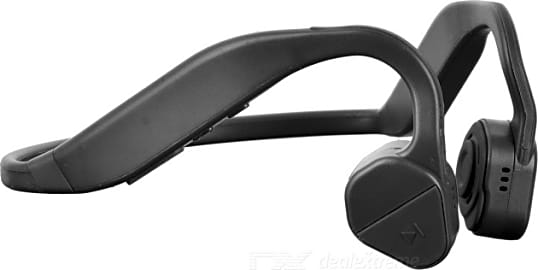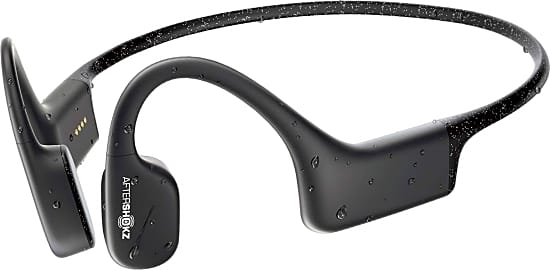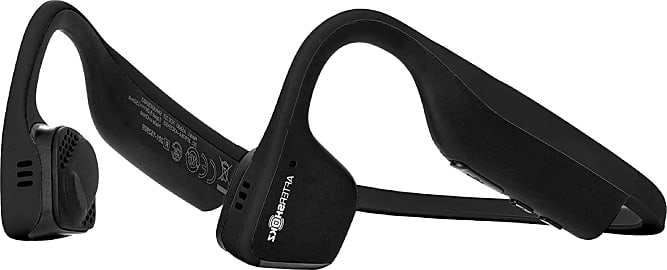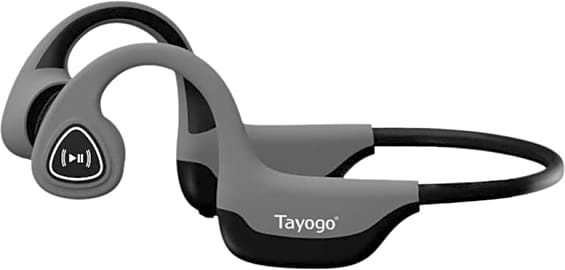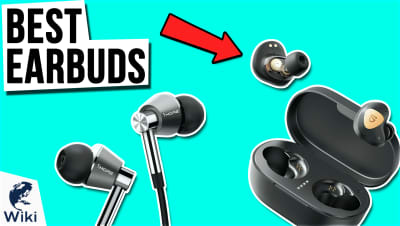The 6 Best Bone Conduction Headphones

This wiki has been updated 30 times since it was first published in October of 2017. Earbuds and headsets aren't ideal for environments where you need awareness of your surroundings, like busy streets or isolated trails. By channeling vibrations directly into the cheekbones, conduction headphones bypass the outer ear, allowing you to hear ambient sounds along with your favorite music or podcasts, so you don't get run over by a truck or have a bear (or worse) sneak up on you. When users buy our independently chosen editorial recommendations, we may earn commissions to help fund the Wiki.
Editor's Notes
October 18, 2020:
Bone conduction headphones are still an evolving technology, so we've refreshed our list to better represent the most up to date options on the market. AfterShokz is still the primary producer of these devices, so it's no surprise they're the creators of the three most cutting-edge selections on our list, namely the AfterShokz Aeropex, the AfterShokz OpenMove, and the AfterShokz Xtrainerz. The Aeropex are the company's current flagship model, and truly the best option you could get by most metrics. Not only do they feature a high-quality build and probably the best frequency response of all bone conduction headphones to date, but they also feature an eight-hour battery life that beats most other models by two hours or more. The Xtrainerz are also a recent release and offer similarly advanced features, however they're definitely not for everyone since they are essentially a pair of headphones and an MP3 player all in one. If you're a swimmer or someone who doesn't like their phone jiggling in their pocket while they exercise they're an awesome solution, but the fact that they can only play songs from internal storage and can't stream from a phone via Bluetooth makes them a relatively niche choice.
Of course, not everyone wants or needs to pay a premium price for top of the line headphones. The AfterShokz OpenMove are the company's current midrange offering, and while they do lack a few features in comparison to the Aeropex the differences are slight. Their ability to play for six hours continuously is plenty for many users, and though their build is ever so slightly more plasticky and weighty than the Aeropex they're still a well-built selection with great sound-quality in comparison to most other choices. The AfterShokz Titanium also made it on to our list, which may seem odd since the OpenMove are essentially their successor. Despite being a few years old they made it on our list because they are actually still a very popular option, and this is because they are less expensive than the OpenMove and only lack features that some users find inconsequential. They're bulkier and heavier than the OpenMove by a small margin, and they're compatible with Bluetooth 4.1 rather than the newer 5.0 standard, however many have found these elements to be mostly unimportant for their experience. If you want to pay a lower price but still want the quality of an AfterShokz brand product, they may be the best option.
Finally, we've included the Vidonn F1 and Tayogo Earphones as affordable options for those who want to try out this technology but aren't interested in the prices AfterShokz models usually command. The Vidonn F1 is relatively similar to the AfterShokz Titanium in terms of functionality, with only minor differences in terms of overall build and sound quality. The Tayogo Earphones are extremely inexpensive and rival the price of normal earbuds, and while they lack the audio-fidelity or premium materials found on higher-end models they are still a worthwhile choice for those who just want to test the waters. Note that they tend to offer less bass and volume than more expensive choices, so they may not be ideal for loud ambient environments.
June 02, 2019:
If you're in the market for a pair of these, first know what they can and can't do. They can transmit decent-quality audio, but only if they fit properly. If the pair you select doesn't clamp tightly to your head, they'll essentially just be tiny speakers blaring tinny sound at your head, and you won't hear much. Also, they just don't put out much bass, because you need to use your actual ears to hear that. But they're great for the middle and high ranges, especially vocals. So if you want a light soundtrack or to be able to hear a phone call, but don't want to block out ambient sounds, give one of these options a try.
You'll notice most of the best options are from AfterShokz. They're one of the few companies that's worked hard at providing a refined product. If you want to spend a little less, the Vidonns are also a worthwhile choice. And we've included a mask-style option that's suitable for use in areas where breathing in particulate matter is a concern.
From The CD To The Head
These microscopic, fibrous tentacles come in two varieties: inner and outer.
When it comes to headphones, there are more configurations to choose from than ever before. Shrinking microchips and advanced production techniques have raised wearable audio to a level of functionality that was practically unimaginable a few decades ago. There are headsets so small they're barely visible in the ear, and there are over-the-ear behemoths intended to block out all external stimuli, and thanks to modern technology, most of them fantastic.
For the most part, all of them work the same basic way. They take in a signal and transmit it to the ear cups, inside which is one of a few different types of driver. The driver converts the electrical signal into vibrations that resonate through a cone and, when on someone's head, go straight for the ear drum. From there, biology takes over.
The sense of hearing is unique because it's one of the shortest, most sensitive pathways to accessing the human brain. The inner ear is highly responsible for sensations of balance and movement in addition to its prominent aural role. So it's fitting that just past the ear drum are layers of incredibly interesting, hair-like cells called stereocilia. These microscopic, fibrous tentacles come in two varieties: inner and outer. The outer hair cells physically transport the vibration through the basilar membrane and into the all-important cochlea itself. The inner hair cells are the part actually responsible for transforming the vibrations into electrical signals ready for the brain to decode and understand.
This is particularly applicable to a moderately obscure, yet nowhere near new method of sound transmission called bone conduction, which essentially skips the entire outer ear, as well as the ear drum, and wastes no time in giving the different hair cells something to talk about.
Hold The Phone, You're Using my Bones?
Have you ever listened to a recording of yourself talking? There's a good chance it sounded pretty awkward, and probably even a little uncomfortable at first. That's because for our entire lives, we've been listening to ourselves speak not through our ears, but through our skull. After all, as you may have noticed, the mouth points directly away from the ears. Rather than the ears, it's acoustic puzzle pieces like the chest, throat, jaw, and face that combine to create the specific resonance with which we're each personally familiar.
That's the general concept behind bone conduction headphones, as well, with one major difference.
That's the general concept behind bone conduction headphones, as well, with one major difference. Each person's unique acoustics modulate the sound of their voice, making recordings sound considerably different than listening to one's self does. When headphones use this method, however, they inject vibrations straight towards the inner ear, by positioning their speaker directly on the adjacent bones. This takes all those other resonance-altering body parts out of the equation, so what a person hears is remarkably close to unaltered. In a way, conduction headphones actually take over at the ear drum's task, communicating directly with the stereocilia.
As with any specialized equipment, there are advantages as well as drawbacks to this interesting technology. First and foremost, it eliminates the need for increasingly painful earbuds or uncomfortably sweaty over-ear cans, and this airflow and openness certainly can't hurt. And because there's nothing blocking the way in, it leaves your ears available to take in other helpful stimuli, such as conversations with other humans, or the rush of oncoming traffic while crossing the street. On the other hand, these headsets can be harder to fit properly on differently sized heads, and their sound quality — particularly the bass — often leave something to be desired. But that's not to disparage their effectiveness; they have been and will continue to be useful for both entertainment as well as medical purposes — that's why they've been around so long.
A Not-So-New Kind Of Can
Roughly 500 years ago, an observant fellow named Girolamo Cardano chomped down on a stick and noticed he could hear vibrations made at its opposing end. Unfortunately, mainstream engineers wouldn't really care for a few hundred more years. In the mean time, though, Beethoven may have crafted himself a rudimentary hearing aid called a rod. When held in the teeth at one end and against a piano at the other, this tool would account for some of his continued composition skill, despite his continuous hearing loss. Similarly, the first and most consistent use of bone conduction has been in the medical, rather than the entertainment or communications fields.
Unfortunately, mainstream engineers wouldn't really care for a few hundred more years.
The first applications of the concept itself came in the 1940s as audiology became a real, fleshed-out discipline. Conduction methods were used then to determine the specific nature of patients' hearing loss, and it's still used in that very same way today. In the '70s, the technology was used in groundbreaking bone-anchored hearing aids designed for patients whose inner ear was intact, but who had lost the ability to hear via standard air conduction. These surgically installed devices were even precursors of sorts to modern, electronic implants that function as artificial cochleas, restoring hearing to individuals formerly without hope.
In the 21st century, increased processing capability and production methods have helped bone conduction develop into a widely used technology. Aside from music listening and medical devices, it's popular in military applications as well as cutting-edge products like the Google Glass. Built-in microphones make some of them especially useful in distraction-filled industrial settings that require the utmost attention to safety. And as long as you know what you're buying, one of these unobtrusive and comfortable sets of headphones can keep you entertained without distracting you from the rest of the world.



